Squatter communities under a bridge, within a cemetery, and on top of a garbage dumpsite are a few of the places in the Philippines that create vivid memories for visiting sponsors.
Last year, Korean sponsors visited their sponsored children living near the city dumpsite of Iloilo. They climbed the mountain of rubbish to observe how the children scavenged. I heard that after their visit, most of them decided to throw away or leave behind their soiled shoes and clothes because the stench would not go away.
A few months later, it was my turn to visit the “mountain.”

At the home of Hannah and Florence, the sponsored children who would take me up the gigantic pile of rubbish, I wondered why they and their mother, Lusita, put on rubber boots, two pairs of pants, and face masks as though they were preparing to go through a gas chamber. They offered me a pair of boots and extra clothing, but I refused and said, “I’m fine.”
Today, I wonder why I didn’t take them.
I’ve been to the crummiest, smelliest and most depressing communities around the Philippines, so I thought that climbing up a pile of trash wouldn’t be any different. I have visited a similar dumpsite in Manila and gotten through it quite well. In Manila, they call it Smokey Mountain because the smell of methane never goes away.
I followed Lusita and her children as we climbed a concrete wall with a barbed wire fence on top. There is open access to this walled dumpsite through the front gate, but Lusita lives at the back side of the wall. That first step just to get to the dumpsite was not easy. Then it was time to hike up the mountain.
As I first stepped onto the squishy mountain grounds, Lusita said the trick was not to look down so I wouldn’t know what I was stepping on. I did look for a few moments and saw a dead bird, fish bones, animal waste, and other gooey stuff with flies swarming.
From all my visits to homes of sponsored children near sewers, garbage pits and slaughterhouses, I have been trained not to cover my nose or make a face lest I offend anyone. This time, however, as we climbed higher and higher, I had to cover my face. Now I know why my companions and everyone else on top of the mountain were wearing face masks.
I pulled my shirt up to my nose and tried to continue walking. I was surprised not only at the foulest smell but also to see so many people there scouring through the pile of trash and filth. They ran toward the garbage truck that just arrived. I ran along not knowing what to expect. They stood behind the truck and as it opened to spew out a new set of smelly garbage, the scavengers raced to get the biggest recyclable chunk that could be sold at the highest price.
I took photos of the commotion and focused on Lusita and the children. I noticed that Lusita sorted through the discarded pieces of rotten vegetables. She feeds her neighbor’s pigs with these, but I later learned that some scavengers eat some vegetable parts that are still “clean” and “edible.”
Despite the smelly and sorry surroundings, the scavengers still seem to be having fun — a very Filipino trait. They laughed, sang, made jokes, and passed around pieces of trash as though they were playing catch with any regular basketball.
On my jeepney ride back to my hotel, it was obvious that people were staring at me. I knew why. I smelled bad. The dumpsite is so smelly that the stench sticks on you.
Inside my hotel room I ran straight to the shower and tried to wash off the smell from my clothes. The stench filled my room. I dumped my clothes and shoes on the bathroom floor and kept the shower running through the night.
From this “mountaintop” experience, I was reminded of two things that I already know:
- Filipinos always make a way to get by.
- Compassion is in places like this, always ready to offer help.







8 Comments |Add a comment
This is a very interesting story it is hard to understand how people can live like this. In 2009 when I was in the Philippines I met 2 guys that went into a dup sight in metro manila they made a video of it… http://www.youtube.com/watch?v=0nOpABj_2no&feature=related
If you don’t mind me asking, what project # are the children who have to dig though the dump from?
I made a mistake. The family Edwin visited is from PH-840. PH-844 is nearby, as are centers: PH-850, 852 and 853.
PH-844
If anyone missed the 10 Questions with Edwin Estioko article that ran back in 2008, here’s the link. It’s really great info if you’re sponsoring kids in the Philippines.
https://blog.compassion.com/10-questions-with-edwin-estioko/
Wow, I would love to see the other pictures….
Edwin, thank you so much for this article and the very powerful photo that accompanies it. I’ve heard stories of these piles collapsing and burying people, children being trapped and killed under metal objects, and human fetuses found within the trash.
I imagine there is a certain sense of excitement in the hunt to see who can find an item of real value. But the danger in these situations, especially for children, is definitely there. It’s tragic that a family would have to rely on this method as a means for survival. What an opportunity for Compassion to work in these communities.
My mother and brother both sponsor children in the Philippines.